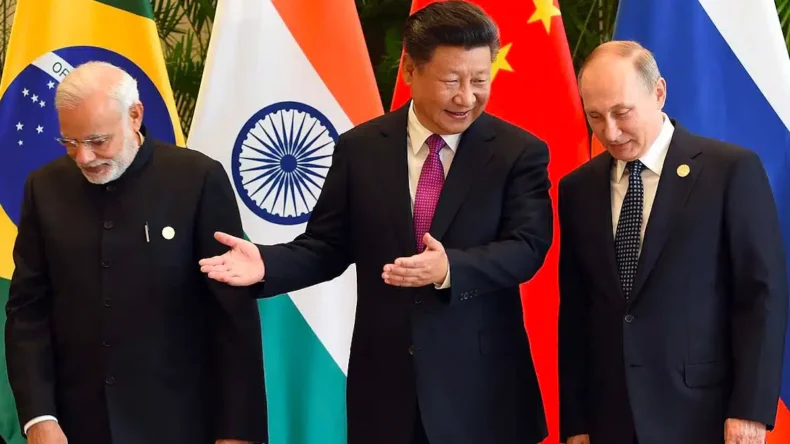By declining to denounce Russia’s military action on February 24, India and China have individually upset and infuriated many in the West. The two BRICS member countries’ neutrality is driven by their respective national interests.
Even though India and China have refrained from voting against the Kremlin in UN votes about Russia’s war on Ukraine and neither Beijing nor New Delhi has denounced Moscow, the two hostile Asian neighbours’ “neutrality” cannot be seen as “the same” or “shared.” Even more significant is the fact that the two nations, who are incredibly friendly to Moscow, do not think well of one another’s bilateral friendship with Moscow. Furthermore, the fact that New Delhi’s reaction to the conflict in Ukraine is influenced by China is a common missing piece in both Chinese and Western understandings of India’s neutrality in the Russian war on Ukraine. “India needs strategic alliances, not just pals who share values.”
Surprisingly, there are few and far-between remarks in the Indian media regarding how Indian and Chinese “neutrality” in the Russia-Ukraine war may have the ability to enable New Delhi and Beijing to make a fresh start amid prevailing hostility and border stalemate. However, there are other Op-Eds highlighting how India-China cooperation might help reduce tensions between Washington and Moscow.
Conversely, signals emanating from Beijing are more affirmative and encouraging of rapprochement with India. Both Beijing and New Delhi were anticipating an “ice-breaking” meeting between the two foreign ministers on the margins of the Shanghai Cooperation Organization (SCO) foreign ministers’ conference in Tashkent last month.
Chinese influence and India’s strategic ties with Russia
As previously indicated, both China and the West, motivated by their subjective interests, have been unable to comprehend India’s geopolitical considerations and strategic considerations behind maintaining New Delhi’s neutrality in the raging conflict in Europe. From a long-term strategic perspective, India is heavily reliant on Russia for its military and defence requirements due to the genuine danger posed by China.
The 3,488-kilometer contested Himalayan border is at the heart of India and China’s decades-long strategic battle for dominance in Asia. Worse, the 1962 border war assured that the two antagonistic neighbours’ usual bilateral relationship eluded them. Recently, the ostensibly peaceful or dormant border erupted into a physical brawl between Chinese and Indian troops in the Galway Valley, at the southeastern edge of Aksai Chin along the Line of Actual Control (LAC) in the high plateau Ladakh region, the size of Switzerland, that has been under Chinese occupation since the India-China war. The 3,488-kilometer contested Himalayan border is at the heart of India and China’s decades-long strategic battle for dominance in Asia.
An estimated 4 Chinese and nearly 20 Indian soldiers were brutally killed in the gruesome brawl in mid-June 2020, amid the high wave of the Covid-19 pandemic spreading across India (but by April-end, the Chinese Communist Party was already celebrating China’s “victory” in the country’s fight against the virus). Tensions on the Indian-Chinese border remained high during Russia’s war on Ukraine. The situation remains tight today, despite sixteen rounds of negotiations between the two forces, and bilateral relations are far from normal. In these circumstances, with India lagging behind China both economically and militarily, India feels a greater need than ever before to have fast access to Russian armaments.
Playing psychological tricks to get an advantage against India is China’s strategy
China was alarmed by India’s proactive involvement in US efforts to contain and isolate China in the Indo-Pacific, particularly the pivotal role India played in the Biden-led revival of the Quadrilateral Security Dialogue (Quad). China saw India’s refusal to stand with the US-led West in denouncing Russia as a “golden opportunity.” As previously said, Wang Yi, the foreign minister of China, almost arrived “uninvited” in New Delhi. By scheduling two back-to-back sessions in one day, one with the national security advisor and the other with the foreign minister Dr Jaishankar, India upheld cultural etiquette and diplomatic protocol.
While the two Indian ministers adhered to their mandate and spoke with the Chinese foreign minister over the protracted border impasse, they also reaffirmed India’s position that “There will be no communication with China until both sides have decided to return the boundary to its previous state by April 2020.” In contrast, Wang Yi reportedly declined to engage in any discussion of the continuing border standoff and insisted that “There will be no communication with China until both sides have decided to return the boundary to its previous state by April 2020. The border situation is tranquil.” is This was according to a portion of the Indian media. Some commentators claim that Wang Yi’s visit when considered in the context of the Ukraine conflict, was simply intended to punctuate New Delhi with the Chinese presence amid an unending series of high-profile visits by/virtual meetings between Indian and foreign leaders from Japan to Australia.
It doesn’t need to be stressed that it wasn’t kept a secret. Beijing was delighted by the apparent sudden rift that had developed over Russian military aggressiveness between Washington and New Delhi as a result of the latter’s “disobedience” In addition, a deluge of Op-Ed articles concentrating on India’s refusal to budge from its “independent” foreign policy position filled the Chinese media. On the day President Biden presided over the Quad leaders’ conference in Tokyo in May, Cankao Xiaoxi, a Chinese tabloid with limited international exposure, cited a source from a prominent Japanese daily.
In conclusion, unpleasant questions were raised in Beijing and numerous Western capitals over India’s steadfast and consistent refusal to side with the West about the events in Ukraine and Wang Yi’s presence in New Delhi.
Read more: https://tdznkwjt9mxt6p1p8657.cleaver.live/













